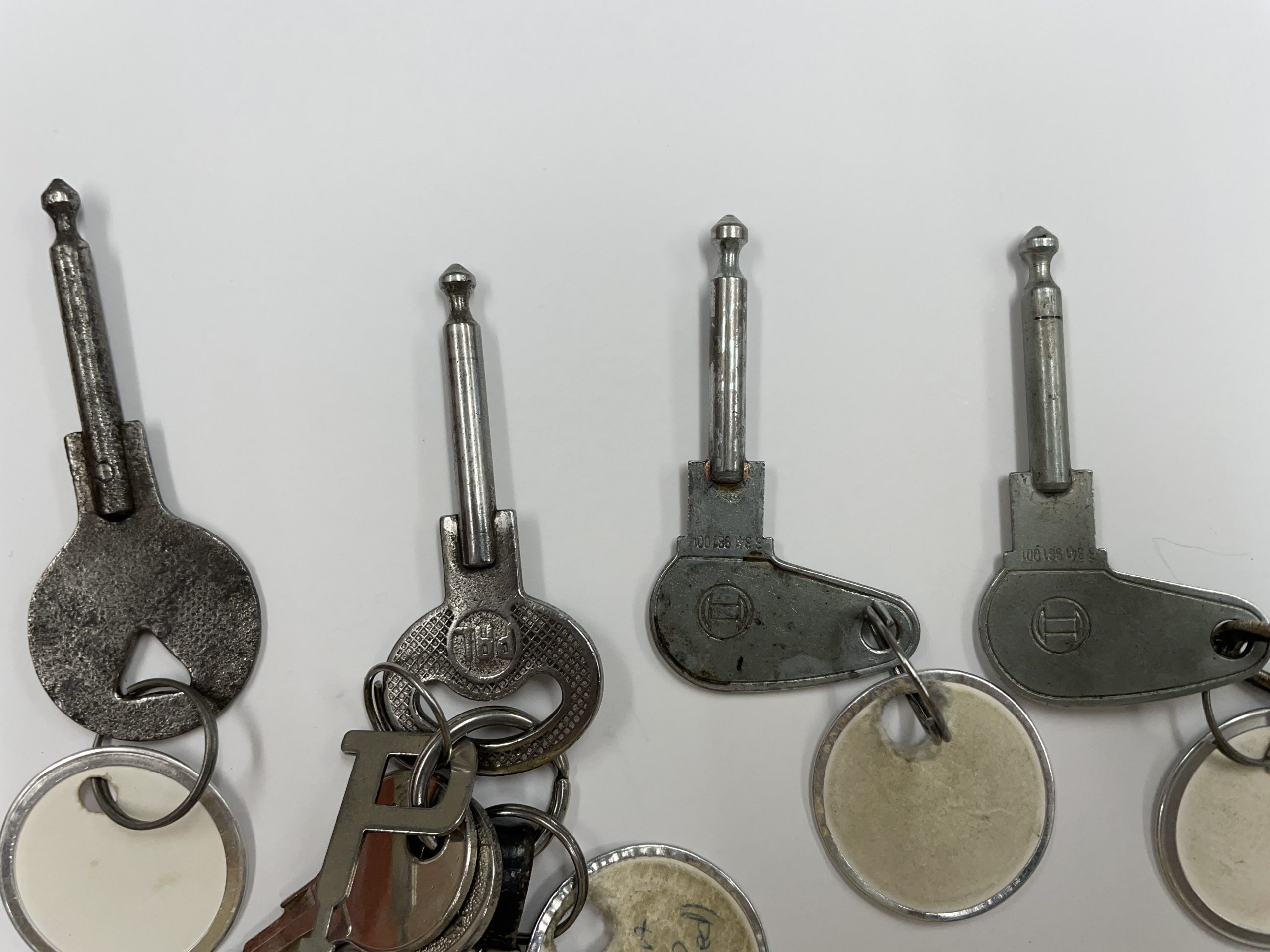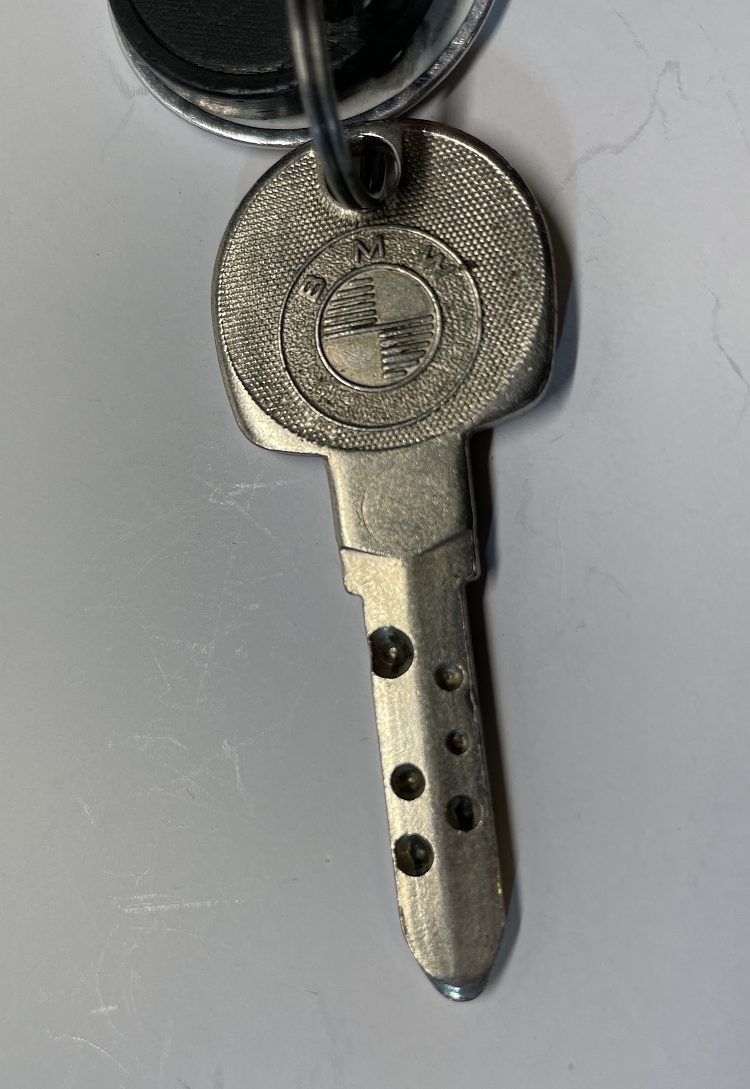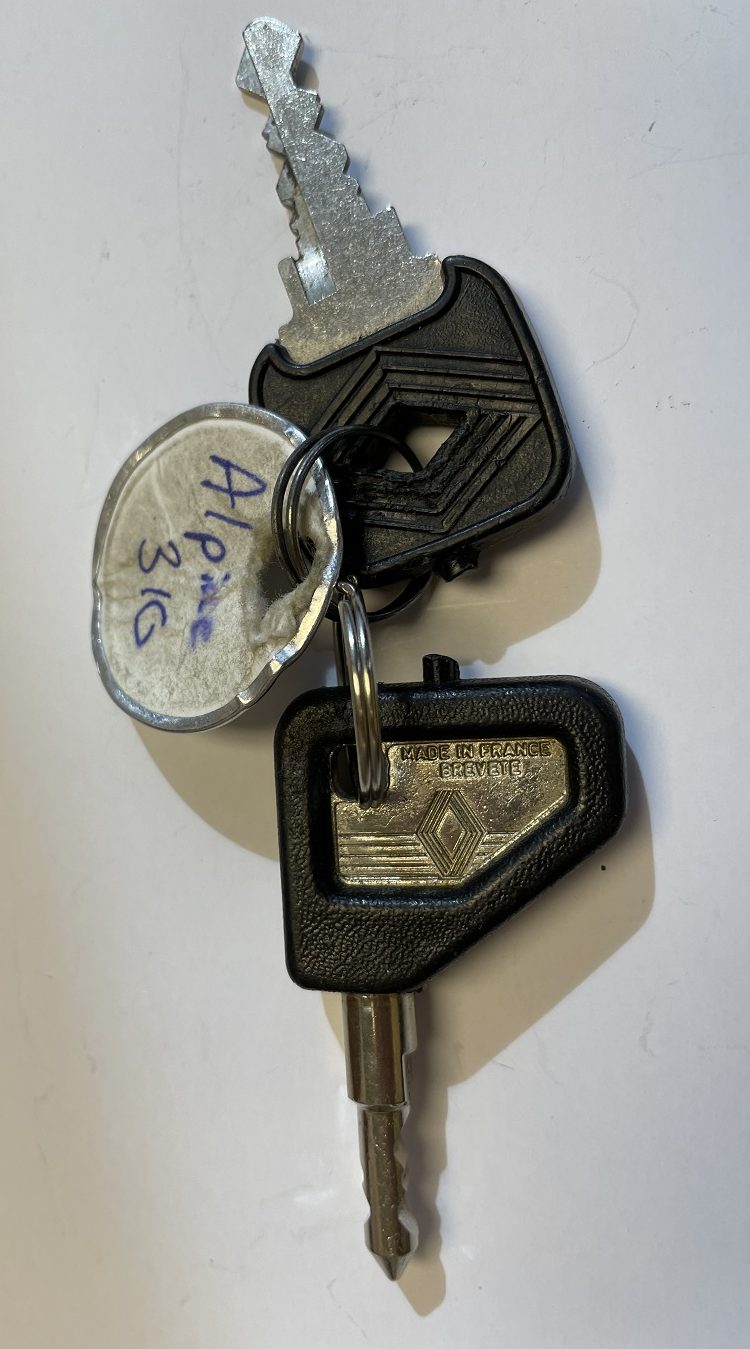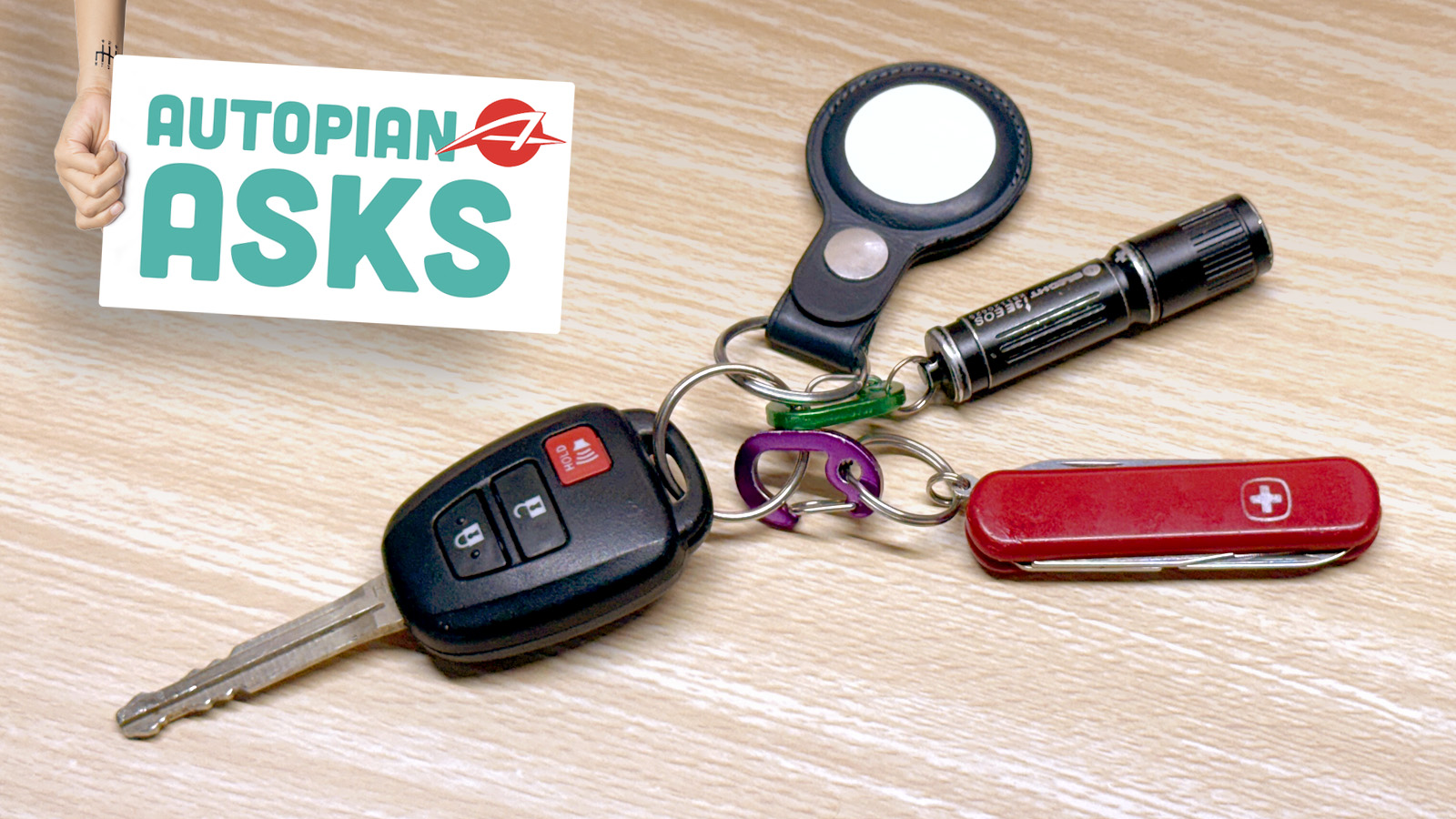Here at Lane Motor Museum, where I work as Education Director, I’ve noticed recently that along with odd and unique cars that we have in the collection, we have several odd and unique ignition and door keys. (Note to young people: car makers used to issue little pieces of metal with teeth cut into them called keys (pronounced KEEZ)). These keys came in various shapes in order to unlock and lock doors, and sometimes they issued a second key entirely that started an engine, as opposed to a remote fob and start button. Weird, right?
Now, with over 550 cars in the collection, I’ve only selected ones that I find interesting looking. There are several cars that either don’t need a key to start the engine in the first place, or don’t have a working ignition lock anymore.
Let’s dig through the Lane’s key cabinet, shall we?

These old-timey fellas are known as ignition nails. While they are all pretty similar in shape, the ends of the nails are tapered or shaped differently depending on make or model. The fact they are not toothed to a specific set of tumblers is a clue to how they operate: by inserting the nail into the ignition, you are simply completing the circuit. The engine could then be started, sometimes by pushing the ignition key in; in other instances, there was a separate button.

The close-up on this Hanomag 2-10 PS Kommissbrot’s key shows that is made by Bosch, who made several of our pre-war nail-style keys.

Let’s jump backwards in time a bit to show you our 1918 Ford Model T’s key. It’s sort-of toothed, and when inserted, you were able to select either power from the magneto or the battery.

Check out this 1934 Tatra T-57’s key. I assume the little holes act as teeth for the tumbler.

This Trojan bubble car key is A) dainty, and B) one of the keys that when inserted, acts as it starting lever. You put the key in the ignition, and push away from the driver to start the engine. Every time I start it, I always feel like I’m going to break the bakelite that encases the metal key. [Editor’s Note: I mean, there is a huge crack in there. – JT]

Jumping ahead to the 1970s, this holed key is from our 1973 BMW Bavaria, the only car BMW sold in North America that did NOT have an alpha-numeric model name, besides the Isetta. It also seems to have the Swiss Cheese holes-as-teeth sort of approach.

Ignore the ID19 key chain, because this folding key is actually from our 1973 Citroën SM. I do not know why the key hinges perpendicular to the plastic grip. It doesn’t fold flat in order to save space in one’s pocket, so I’ll have to do some research as to why the key is designed this way. Knowing French engineers in the 1970s, there has to be a reason.

This 1985 Renault Alpine 310’s key has an end that is similar to an old ignition nail. It’s also smaller in size compared to other European 1980s keys.

Skipping ahead in time, this 2013 Lotus Evora S key has to be one of the last thin, British metal keys to be manufactured. For decades, Jaguar issued these distinctive cylindrical keys. Does anyone know if these Jag-style keys had a name?
[Editor’s Note: I do, Rex! These are called Tibbe locks, and Ford used them as well. Instead of tumblers like most locks, these use a series of discs that the notched key cylinder slides into. Here’s a nice video of how to pick these locks, in case you want to, you know, steal a Jaguar.
I meant learn how they work! Not steal. – JT]

Ok, I know I was teasing the youths earlier, but we do have more modern cars in the collection with interesting remote key fobs. This Porsche 911 50th anniversary edition’s remote is shaped like the car itself, yet has to be inserted and twisted to start the car. Of course, this being a proper 911, the ignition is located to the left of the steering column.


Our last interesting key is from our JDM 2014 Honda N-One. It’s one of the few cars in the collection that has a proximity key and a push-button start. However, if you know your late model Honda motorcycles, you’ll notice this is the same key as found on many of their two-wheeled offerings. I assume it was just easier to use an existing Honda product.
If you think keys can be interesting and unique, oooh boy, do I have content for you. As many of you are taillight aficionados like Torch, I’ll be doing a show-and-tell of semaphores and odd turn signal indicators soon.
[Editor’s Note: HOT DAMN – JT]








Very late to the game here, but I’ve had that N-One fob in my hand, driving it around snowy Vermont.
I think the SM key is designed like that for security, in case of an accident you don’t impale that much on it, Citroën always focus on security but with weird choice like their turn signal who don’t cancel so that they don’ turn off too early.
The nail keys looks suspiciously like a 1/4″ jack connector, maybe you can plug your earphones or your electric guitar.
Thanks Torch! I knew someone knew what they were called. Fascinating.
Oh man! Those dimpled BMW keys. Back in the 90s my 76 3.0 Si (the hotrod version of the Bavaria) was stolen with the keys inside. Longer story, but yeah, basically I’m dumb. It was found 3 months later abandoned without the keys inside and the cops told me I could pick it up at the impound.
Oh boy! I called my mechanic and he said I might as well write it off as the car is basically totaled without a key. The car was pretty trashed anyway so I let her go. Looking back I probably could have saved it as I think my mechanic just didn’t want to deal with the hassle and those dimples scared me too much to attempt it myself.
Those are not as terrible as all that. It was an attempt to reduce lock picking by turning the pins in their sides. It was a popular approach in locks in general for about 20 years. A new tumbler and lock could be done, but A decent locksmith at the time could have made a new key. It would only be totaled if the value of the car was under $500.
I think the first-gen Dodge Neon’s glow-in-the-dark keys have a place in here.
Here is a picture of the “key” to my Tesla –
I see what you did there (or did not do).
As a few others have commented the nail keys are remarkable similar to a 1/4 instrument jack. Taking that a little further back the 1/4″ jack was developed in the 1880s for telephone switchboards. So whenever you see an old timey switchboard operator plugging in and unplugging wires, that is the connector. Based on how the 1/4″ jack is held in place I would guess that the automaker just wanted some cheap and simple way to have an electrical connection open or closed that wasn’t a physical switch that could break easy.
Yes! Bring on the semaphores and trafficators!
The ignition nails look so much like regular audio jack plugs! I wonder if it’s the same size (6.35mm/ 1/4″) and if there’s some connection between the two. One of the Hanomag keys even has a ring, like the one you’d find in a TS jack tip, commonly used for mono audio signals and modular synthesis patching (although in modular setups the standard these days is the 3.5mm TS minijack).
That key from the Alpine A310? I’ve had two of those, and neither was from an A310: one was from a 1989 Renault Espace Quadra, and the other from my current daily driver, a 1991 Renault 4. I love it that the same type of key was being used in every car Renault manufactured at the time, from the absolute bottom of the lineup to high end offerings like the original Espace and the A310.
Now, sharing key formats isn’t always great. That Lotus key right below the one from the A310? Like the editor’s note mentions, it was extensively used by Ford for a long time in all sorts of vehicles. The problem is, either the key’s security features sucked, or there weren’t that many variations, so you have lots of stories of keys from a car opening and starting an entirely different car. My father had a 1990 Fiesta that he traded in in 1994 for an Escort; the spare key from the Fiesta, which was supposedly lost when my father sold it but eventually reappeared, opened and started the Escort without a hint of resistance. I also remember someone who supposedly got in their car (another Fiesta MK3) in the supermarket parking lot and was about to drive off, engine idling and all, when they looked around the interior and realised it wasn’t their car, just a similar one parked in a similar spot in the wrong row of parking spots.
I have heard stories like that countless times (most recently five comments earlier), and they have always been about Fords – European and American ones alike.
I also have heard this numerous times about old VW keys.
I have these two firsthand examples but I’ve heard about countless others that supposedly happened to a friend of a friend, always with 1990s-2000s EU Fords. Hard to believe everyone just decided to lie about it.
The Lotus key is a Ford item. Ford owned Jaguar at one point, so the Jag ones are Ford too.
My early Elise had a GM key, the same as my 80’s Vauxhall. It had a massive rectangular plastic end on it that I cut down in to the same triangular shape from the middle of the Lotus badge.
I have some experience of the 911 key, it looks great, but it’s huge. If the intent was to create and unsightly trouser bulge then job done.
^ this, most British cars are parts-bin designs using whatever the parent company / donor supplier has available.
Hence Morris Marina door handles cropping up on everything from Lotus to Range Rover for decades after the last Marina was ever seen on the road.
Both the original door and ignition keys for my ’64 F100 crewcab were the same shape. Dad filed a notch in the door key to be able to tell them apart at night.
came here for the Tatra, only saw it’s key… time well spent.
I have some old Lancia keys laying around if you want / need any.
A couple decades or so ago a friend bought a 1972 BMW 2002 from the original owner who provided the original key which was hinged like that Citroen SM’s key & said that it was for safety reasons where the driver wouldn’t be injured by a key sticking out in the event of a crash. But that was rendered pretty much moot when the key was put on a keyring so it couldn’t fold flat. Yeah, it’d be cool to see what you find out about the SM’s key especially since it seems like it wasn’t just typical French engineering and, seconding JT, it’d also be great to see what you post about semaphores & odd turn signal indicators.
Yeah, I thought about the safety aspect too, but you’re right about a keyring negating that. I’ll do some more digging.
Top gear did a review of one – https://www.topgear.com/car-reviews/citroen/sm
There’s two images with the key cylinder visible – https://www.topgear.com/sites/default/files/cars-car/carousel/2021/04/l1180715.jpg?w=1952&h=1098 and https://www.topgear.com/sites/default/files/cars-car/carousel/2021/04/_dsc3187.jpg?w=1952&h=1098
In both they look to have the axis of rotation for the key basically parallel to the drive wheel spin axis. Additionally, since the key looks to be non-symmetric, I think the ring and ignition cylinder shroud / steering column combined with the ring on the key force the correct insertion direction without having to try twice.
I bet it was a cost save on the tumbler / key blanks to only have one key direction, so they designed the key body to make it easier to reliably insert first time in the correct direction.
That BMW Bavaria key is bonkers, and I would really like to know how the lock works.
Had a car with a similar key to the BMW’s. I can’t remember what, wasn’t a BMW though, probably Japanese. Old BMW/Bosch ignition switches said “Fahrt” instead of the English “start”
Heh heh that looks like fart
*beavis and butthead laugh* you said “fart”
On a mostly unrelated note: I’m still mad at myself for not buying a “Where the hell is Ausfahrt?” bumper sticker when I was in Germany.
Those ignition nail keys are fascinating. Nowadays one might call them headphone jack keys. This might be a myth but I remember something about Kawasaki having only a few different keys in the early seventies. If you saw a Kawasaki the same model year as yours, chances are the key would fit.
My Grandmother inadvertently stole a car once due to an issue with the keys being too similar. This was in the late 1970’s and she drove a luxed-out 1976 Ford LTD sedan, bright yellow. For those of you who aren’t familiar, this was an 18 1/2 foot long, 6 1/2 foot wide behemoth sporting Ford’s 460 CID V8, and I have fond memories of riding around in it with her. It was a living room on wheels, and not hard to find in a parking lot.
One day, she went to the grocery store and when she came out, she unlocked the cavernous trunk, loaded the groceries, got into the car, started it up, and drove home. It wasn’t until she got all the way back that she realized that, although it was a bright yellow LTD and worked with her own keys, it wasn’t her car! She drove it back to the store and there was the owner of the car she “stole” waiting next to her car. She was embarrassed, but everyone was glad to have their own car back.
A former boss of mine had a Taurus, or maybe it was a Five Hundred, and one day he went to a mall and happened to park near the Sears Auto Center. When he came out, the car was gone. He went to the service desk and asked to use their phone to report his car stolen.
The person behind the desk asked what kind of car it was, then pointed to one of the service bays: “Like that one?” Yep, two Taurii with identical or close-enough keys had landed in the same parking lot. I think he got free tires or something out of it.
My mom had one of the Ford Explorers with the recalled Firestone tires on it. The shop calls and tells us the new tires have been installed and we can come pick it up. As I am walking in from the parking lot I pass by her car and notice it still has the old tires on it. I get inside and ask why they said it was done when they hadn’t even moved it from the parking spot we left it in. Turns out they replaced the tires on a different Explorer that they unlocked and started using the key to my mom’s Explorer. Maybe back then if you had a Ford key you could drive any Ford?
(I think I told this story on the other site?)
My boss goes to the State Motor Pool for a loaner to drive 45 minutes north for his meeting in Tacoma. He’s given a Ford key with a numeric label attached (we’ll say 14).
He wanders about ’til he finds slot 14, occupied by a Mustang II. Thinking “That seems an odd choice for a motor pool loaner” he unlocks the door and climbs in. Noticing ash in the ashtray and a potato chip bag in the passenger seat, he thinks “It’s odd they didn’t clean this thing up better!” he starts the engine and heads north.
Driving north, he notices the fuel gauge reads half empty, and wonders “It’s weird they didn’t fill it up this time . .”
Upon return at the end of his day, he’s greeted by some befuddled Motor Pool folks and a disgruntled car owner (who, it happens, had reported a car theft on her lunch break).
Turns out the Escort’s key exactly matched that of the Mustang, AND parking garage slot 14 wasn’t the same as Motor Pool outbound spot 14.
The Alpine keys look like they open a small gun safe.
Speaking of letting young people know what used to be normal, Two Keys One Car;
(These are uncut blanks, the notches are only on on side of the shaft) https://i.ebayimg.com/images/g/~QEAAOSwzc5g7ETP/s-l500.jpg
GM used the square head key for ignition only and the round for door and trunk locks.
Chrysler used a Pentastar-shaped head for ignition and doors and the round for trunk only.
Ford issued square and round keys but I don’t remember their division of function. AMC for that matter.
It was always pretty much just a Detroit thing.
The square-head Ford key was/is for the ignition. The oval key opened the doors and trunk. In Fords, the key and lock grooves were reversed so the driver could not insert the wrong key into the lock. Source: Me. As a kid, I worked in a hardware store and cut thousands of keys.
If memory serves, in the 1960s and later, Briggs & Stratton of small engine fame manufactured the locksets for GM and AMC vehicles. I cannot recall if the GM and AMC key blanks were interchangeable.
And if you were around a real beater, it might have had another key for the trunk lid that was replaced somewhere along the line. I never had that, but I knew a couple of people who did.
Also particularly fun was a GM ignition worn to the point of no longer needing a key at all, but that’s not the key’s fault. My dad’s stepside Chevy had that issue.
Me too! IIRC, my ’50 Chevy (inherited from my grandfather) had two little “ears” around the key receptacle to make it easier to turn. Eventually, it was a LOT easier: I didn’t even need the key!
Chevy used that ignition “lock” design for years. Decades, maybe.
That was exactly how we started it! Those ears would certainly be handy for anyone who wanted to steal it (no one wanted to steal it)!
Yes, I actually forgot about this. My first car was a 1985 Cutlass Supreme and it had two keys.